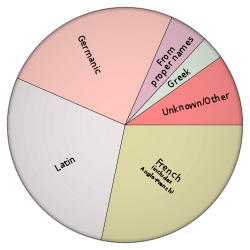Morphology: really, I must decline
Here’s a rare educational post!
It is a fairly well known fact that English borrows words and word roots from a variety of sources. Wikipedia states that that majority of English roots come from Latin and French (Old Norman), though the 100 most frequently used words are all Germanic in origin. This graph demonstrates a full breakdown, taken from a sample of 80,000 words from the Shorter Oxford Dictionary:
Although we have a rich vocabulary (by far the widest of all languages, with some 2 million words at last count), the English language treats nouns and verbs (and, to an extent, adjectives and pronouns) rather differently from the Romance languages from which it borrows heavily. One of the main differences is in the morphology of words – that is, how they change depending on gender and number (for nouns and adjectives), and person, mood, voice, and tense (for verbs). Verbs in English, for example, do not change in form much, usually adding an ‘s’ in the third person singular. For example, the verb “to see”:
| I see You (singular) see He/she/it sees We see You (plural) see They see |
In the future tense, the verb form (or inflection) itself does not change at all – instead, we use the auxiliary verb “to be” in its future tense, and the present participle of the verb (in this case, “see”). For example:
| I will see You (singular) will see He/she/it will see We will see You (plural) will see They will see |
This makes learning regular English verbs pretty easy. Making a “verb table” like this seems a little pointless in English, since there are only two different forms in the present tense for this particular verb. This process is also known as conjugating a verb.
Let’s compare our relatively simple English verb table (the top one, indicating the present tense) with the French equivalent, then – the French verb to see is voir:
| Je vois Tu vois Il/elle/on voit Nous voyons Vous voyez Ils/elles voient |
There are 5 different forms here. The future tense in French has another 6 different forms (je verrai, tu verras, il verra, nous verrons, vous verrez, ils verront), meaning that there’s a whole lot more learning to do.
Likewise, nouns in English have a singular and plural form – we don’t have to worry about gender or case, which explains why these are seen as new and slightly unusual concepts when it comes to learning a language like Spanish, French or German.
Let’s take the word ‘table’ as an example (since above I listed two ‘verb tables’) – in English, you either have a table, or you have several tables. Singular and plural – simple, right? Let’s compare the Latin word for ‘table’ (mensa, which happens to be a 1st declension feminine noun) and see how many forms it has (listing the different forms for a noun is also known as declining):
| CASE | SINGULAR | PLURAL | Nominative | mensa | mensae |
| Vocative | mensa | mensae |
| Accusative | mensam | mensas |
| Genitive | mensae | mensarum |
| Dative | mensae | mensis |
| Ablative | mensa | mensis |
You can safely avoid the case names for now (though you may recognize a few), but straight away you can see that there are far more noun forms in Latin than in English (in this case, 7 different inflections in Latin vs. only 2 in English). Latin is perhaps an extreme example here, since it is an extremely inflective language and relies on the inflections of the words to ‘fill in’ the rest of the words in a sentence far more than English does. Moreover, this is just how you decline 1st declension feminine nouns in Latin – there are 5 groups of nouns, most of which have several genders, and there are all kinds of identical and similar forms across the groups, meaning that you really have to know your word endings to understand what is going on.
This is just a short demonstration of morphology at work, and barely begins to touch on the subject. However, if you’re thinking of learning another language (especially if it’s a Romance language), then it’s useful to see what you’re going to be up against. Learning your nouns and verbs in all their forms early on in your studying – especially the irregular ones – will put you in a much better position once your vocabulary expands and you start learning more complicated constructions and idioms, which sometimes combine several forms to create different or subtler meanings.
Sorry for all the technical talk – I hope this was useful to some!

